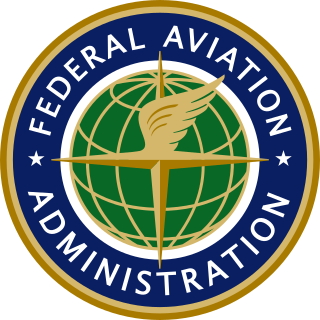
The Federal Aviation Administration (FAA) is a U.S. federal government agency within the U.S. Department of Transportation which regulates civil aviation in the United States and surrounding international waters. Its powers include air traffic control, certification of personnel and aircraft, setting standards for airports, and protection of U.S. assets during the launch or re-entry of commercial space vehicles. Powers over neighboring international waters were delegated to the FAA by authority of the International Civil Aviation Organization.
Airspace is the portion of the atmosphere controlled by a country above its territory, including its territorial waters or, more generally, any specific three-dimensional portion of the atmosphere. It is not the same as outer space which is the expanse or space outside the Earth and aerospace which is the general term for Earth's atmosphere and the outer space within the planet's vicinity. History:
The Air Commerce Act of 1926 created an Aeronautic Branch of the United States Department of Commerce. Its functions included testing and licensing of pilots, certification of aircraft and investigation of accidents.

A fixed-base operator (FBO) is an organization granted the right by an airport to operate at the airport and provide aeronautical services such as fueling, hangaring, tie-down and parking, aircraft rental, aircraft maintenance, flight instruction, and similar services. In common practice, an FBO is the primary provider of support services to general aviation operators at a public-use airport and is on land leased from the airport, or, in rare cases, adjacent property as a "through the fence operation". In many smaller airports serving general aviation in remote or modest communities, the town itself may provide fuel services and operate a basic FBO facility. Most FBOs doing business at airports of high to moderate traffic volume are non-governmental organizations, either privately or publicly held companies.
The National Aeronautic Association of the United States (NAA) is a non-profit 501(c)(3) organization and a founding member of the Fédération Aéronautique Internationale (FAI). Founded in 1905, it is the oldest national aviation club in the United States and one of the oldest in the world, it serves as the “Aeroclub of the United States” and, by its Mission Statement it is "…dedicated to the advancement of the art, sport and science of aviation in the United States.” The NAA is headquartered at the Ronald Reagan Washington National Airport, in Washington, D.C.

Dobbins Air Reserve Base or Dobbins ARB is a United States Air Force reserve air base located in Marietta, Georgia, a suburb about 20 miles (32 km) northwest of Atlanta. Originally known as Dobbins Air Force Base, it was named in honor of Captain Charles M. Dobbins, a World War II C-47 pilot who died near Sicily.
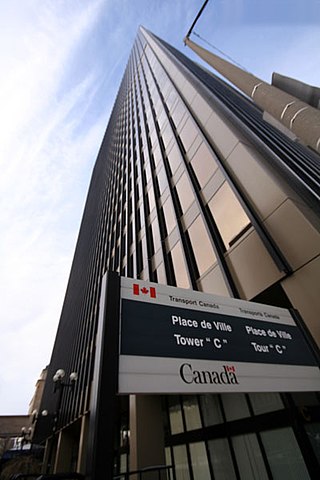
Transport Canada is the department within the Government of Canada responsible for developing regulations, policies and services of road, rail, marine and air transportation in Canada. It is part of the Transportation, Infrastructure and Communities (TIC) portfolio. The current Minister of Transport is Pablo Rodriguez. Transport Canada is headquartered in Ottawa, Ontario.

Sheppard Air Force Base is a United States Air Force (USAF) base located five miles (8.0 km) north of the central business district of Wichita Falls, in Wichita County, Texas, United States. It is the largest training base and most diversified in Air Education and Training Command. The base is named in honor of Texas Senator John Morris Sheppard, a supporter of military preparations before World War II.

Merced Regional Airport is located two miles (3.2 km) southwest of Merced, in Merced County, California. The National Plan of Integrated Airport Systems for 2021–2025 categorized it as a Commercial Service – Nonprimary airport. Commercial passenger service is subsidized by the Essential Air Service program.
The Michigan Department of Transportation (MDOT) is a constitutional government principal department of the US state of Michigan. The primary purpose of MDOT is to maintain the Michigan State Trunkline Highway System which includes all Interstate, US and state highways in Michigan with the exception of the Mackinac Bridge. Other responsibilities that fall under MDOT's mandate include airports, shipping and rail in Michigan.

The Civilian Pilot Training Program (CPTP) was a flight training program (1938–1944) sponsored by the United States government with the stated purpose of increasing the number of civilian pilots, though having a clear impact on military preparedness.
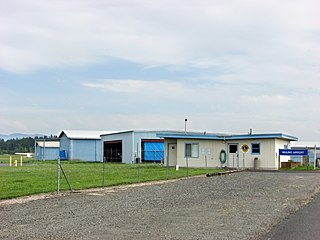
Mulino State Airport is a public airport located at Mulino, Oregon, near the city of Molalla, about 20 nautical miles south of Portland with access from Interstate 205 via Oregon Route 213. Also known as Mulino Airport, it was owned by the Port of Portland from 1988 until it was transferred to the Oregon Department of Aviation on July 1, 2009. It was previously also known as Portland-Mulino Airport.

Chicago/Aurora Municipal Airport is a public airport opened in April 1966, located in the village of Sugar Grove, Illinois, United States, 8 miles (13 km) west of the city of Aurora, both in Kane County. The airport is owned and operated by the City of Aurora. It is 50 miles (80 km) west of Chicago and is designated as a reliever airport for Chicago's O'Hare and Midway airports.

The Oregon Department of Agriculture (ODA) is responsible for agriculture in Oregon. This agency of the government of the U.S. state of Oregon promotes and regulates food production and safety. It is headed by the director of agriculture, appointed by the governor of Oregon, subject to confirmation by the senate, advised by a board of ten members, and gubernatorial appointees. Through its nine divisions, it administers no fewer than 36 chapters of Oregon laws.

The Civil Aviation Authority of the Philippines is the civil aviation authority of the Philippines and is responsible for implementing policies on civil aviation to assure safe, economic and efficient air travel. The agency also investigates aviation accidents via its Aircraft Accident Investigation and Inquiry Board. Formerly the Air Transportation Office, it is an independent regulatory body attached to the Department of Transportation for the purpose of policy coordination.
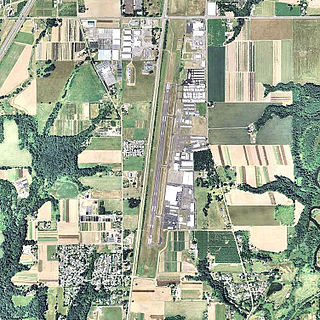
Aurora State Airport is a public airport located one mile (2 km) northwest of the central business district of Aurora, a city in Marion County, Oregon, United States. It is owned by the Oregon Department of Aviation.

Seaside Municipal Airport is a general aviation airport located one mile (1.6 km) Northeast of Seaside in Clatsop County, Oregon, United States. It is owned and operated as a public airport by the city of Seaside. The airport has one asphalt runway, a parallel taxiway, a parking apron with space for up to 20 aircraft, and a five-bay hangar building. Seaside Municipal is the closest airport to Seaside, Gearhart, and Cannon Beach.
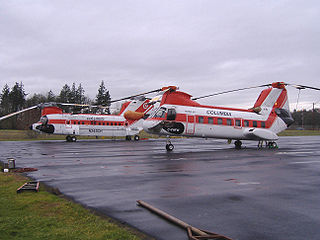
Columbia Helicopters, Incorporated (CHI) is an aircraft manufacturing and operator company based in Aurora, Oregon, United States. It is known for operating tandem rotor helicopters; in present times, exclusively the Boeing Vertol 107 and Boeing Vertol 234. These helicopters are used in stream restoration and forestry, including heli-logging, aerial firefighting, oil exploration, construction, government support, film production, disaster response, and many other activities. In addition, the company operates a large FAA repair station supporting customers worldwide.

Robert Llewellyn Sumwalt III is an American academic, aviator, government official and writer. He was a board member of the National Transportation Safety Board for over 15 years, from August 2006 to June 30, 2021, serving as the agency's chairman from 2017 to 2021. He currently serves as the executive director of Embry-Riddle's Boeing Center for Aviation and Aerospace Safety.
















